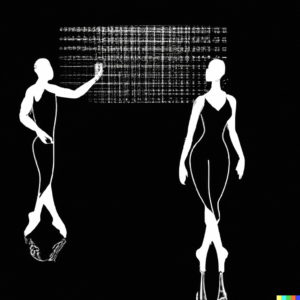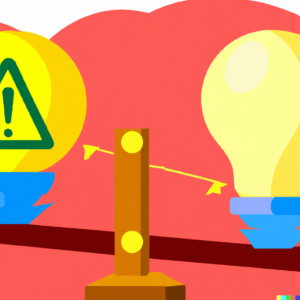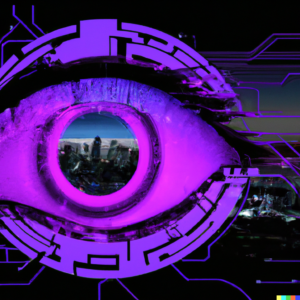The Balancing Act of AI and Privacy
Welcome, dear readers! Today, we’re venturing into the intricate dance between artificial intelligence and privacy, two entities that have found themselves locked in an increasingly complex waltz in our modern, data-driven world.
At the heart of this dance is a paradox. On one hand, artificial intelligence, with its insatiable thirst for data, can be perceived as a threat to our privacy. On the other, this same technology holds enormous potential to defend and even enhance our privacy in ways we’ve never imagined before. The dance floor, therefore, is a battleground where crucial questions arise: How can we harness the power of AI without compromising our fundamental right to privacy? How can we navigate the swirling complexities of this dance without stepping on each other’s toes?
In this post, we aim to untangle the intricate steps of this dance, exploring both the challenges and opportunities that the intersection of AI and privacy presents. We’ll delve into why AI needs data, scrutinize the privacy implications of this need, and examine the potential risks and rewards inherent in integrating AI into our everyday lives.
Join us as we navigate the twists and turns of this fascinating subject. The dance is about to begin.
The Data Dilemma: Why AI Needs Data and the Privacy Implications
Our dance begins with an understanding of AI’s relentless craving for data. Data is the lifeblood of AI. It’s the food that feeds machine learning algorithms, allowing them to make sense of the world, recognize patterns, and ultimately, make predictions and decisions.
Consider a simple AI application like a recommendation system on a streaming platform. To give you a personalized movie or music suggestions, the system needs data: your past choices, browsing habits, and pause and skip patterns. Without access to this kind of data, the AI couldn’t ‘understand’ your preferences and provide personalized suggestions.
However, this hunger for data is where privacy concerns begin to creep in. In the quest to feed data-hungry AI systems, there’s a risk of collecting too much information, including personal and sensitive data. Often, users are not fully aware of the extent of data collection or how their data is being used. Further, data breaches and misuse of data are real threats in today’s world, elevating privacy concerns.
This is the paradoxical dilemma at the heart of AI: a system that provides incredibly personalized, efficient, and effective services, but potentially at the expense of individual privacy. And as AI systems become increasingly embedded in our daily lives, this data-privacy conundrum grows ever more intricate.
AI as a Threat to Privacy: Notable Examples and Scenarios
Just as we’ve established why AI is so dependent on data, it’s time for us to tackle a less comfortable topic: how AI can potentially pose a threat to privacy. The double-edged sword of AI’s data reliance is that the same systems that can make our lives easier can also expose our most intimate details, sometimes in ways that are less than ideal.
Take, for instance, the field of online advertising. AI-driven targeted advertising can seem uncannily accurate, presenting us with the exact product we’d been thinking about but hadn’t voiced aloud. Behind this seeming serendipity is an array of AI systems analyzing our online behavior, demographics, interests, and more. While some may argue that such precision creates a more personalized and efficient shopping experience, it also raises critical questions about how much these AI systems know about us and who else has access to that information.
Another prime example is facial recognition technology. In many ways, it’s a remarkable tool with numerous beneficial applications—from unlocking our smartphones to aiding law enforcement in identifying criminals. Yet, its darker side reveals a potential for mass surveillance and the erosion of anonymity in public spaces. The ability of AI systems to identify and track individuals based on their facial features is a vivid example of AI’s potential threat to privacy.
Yet another scenario is the healthcare sector, where AI is rapidly gaining traction. Here, the technology’s need for extensive, detailed personal health data to function optimally can potentially clash with the stringent requirements for privacy and confidentiality in health care.
These examples represent just a few of the ways AI can unintentionally encroach on our privacy. This is not to vilify AI but to underscore the importance of understanding the potential pitfalls of AI’s interaction with our personal data. It’s a necessary examination, even as we acknowledge the enormous potential benefits of AI. In our next section, we’ll flip the script and look at how AI can be a defender of privacy, providing innovative solutions to these challenges.
AI as a Defender of Privacy: Innovative Solutions and Opportunities
While it’s critical to highlight the potential risks that AI can pose to privacy, it’s equally important to shed light on the flip side of the coin: AI’s potential to enhance and protect our privacy. Yes, you read that correctly. The same technology that can intrude on our privacy also offers innovative solutions to safeguard it. This is not just about turning the tide; it’s about harnessing the power of AI to redefine the landscape of privacy protection.
One such development is the concept of “differential privacy”. A brainchild of the AI research community, differential privacy is a mathematical technique that allows companies to collect and share aggregate data about user habits while maintaining the privacy of individual users. By adding a degree of statistical noise to the data, individual user information gets obfuscated, thereby protecting individual privacy while still providing valuable insights.
Along a similar vein, the idea of “federated learning” has been gaining traction. Instead of centralizing data to train an AI model, federated learning allows the model to be trained on the user’s device itself, learning from data without the data ever leaving the device. The AI system can still learn and improve, but the user’s data stays private and secure.
AI is even being used to detect and alert users to privacy violations. AI systems are now capable of scanning and understanding the terms and conditions of various platforms, alerting users to potential privacy concerns. In other cases, AI can monitor network activity to detect unusual data flows that might indicate a breach of privacy.
These examples showcase the potential of AI to not only respect privacy but actively defend it, making privacy protection an integral part of its functionality rather than a bolted-on afterthought. As AI technology continues to evolve and improve, there is hope that the AI-privacy paradox can be resolved in a manner that safeguards individual privacy while still unlocking the vast potential of AI. Next, we will delve into the current legal landscape shaping the intersection of AI and privacy.
The Framework of Law: Bridging AI Ambitions with Privacy Protections
In the evolving dance of AI and privacy, an important partner has been introduced: the rule of law. Legal systems worldwide are wrestling with the task of controlling the AI and privacy sphere in a manner that encourages progress but also safeguards individual privacy rights.
The European Union has set a benchmark with its General Data Protection Regulation (GDPR). This wide-ranging legislation has revolutionized the way organizations manage consumer data, imposing stringent guidelines on data collection, storage, and processing, with hefty penalties for non-compliance. Notably, it also addresses issues specific to AI, such as the “right to explanation” where individuals can demand an explanation for an AI-generated decision that impacts them.
In contrast, the regulatory landscape in the United States is somewhat fragmented. Individual states, like California, have enacted their own comprehensive privacy laws. The California Consumer Privacy Act (CCPA), for instance, offers consumers greater power over their personal data, including the right to know what data is being gathered, the right to delete personal data held by businesses, and the right to opt out of their personal data being sold.
Similarly, in Asia, countries like Singapore are updating their regulatory frameworks to balance AI-driven innovation with trust, which comes with robust governance.
However, as much as these regulations represent critical steps toward tackling the AI privacy paradox, they also present new hurdles. Compliance can be expensive and complex, especially for smaller businesses, and the variances in laws across countries can create confusion and uncertainty.
Navigating this legal maze is a crucial aspect of the AI-privacy dance, guiding the steps of businesses, governments, and individuals alike. In the next section, we will contemplate the future of this dance and the importance of preserving equilibrium.
Looking Forward: Balancing AI Innovation and Privacy
As we step into the future of AI, it’s clear that the dance with privacy will continue to be a central part of the narrative. As AI continues to innovate and transform every facet of our lives, it’s essential to ensure that its evolution is accompanied by a deep respect for individual privacy. Striking this balance is undoubtedly challenging, but it’s a challenge we must rise to meet.
On one hand, we have AI’s unrelenting appetite for data—the fuel for its insights and innovations. On the other hand, we have the fundamental right to privacy—a cornerstone of our individual autonomy and freedom. Squaring this circle requires thoughtfulness, innovation, and a keen understanding of both the technology and the underlying ethical principles.
Innovation will continue to play a crucial role. Techniques like differential privacy and federated learning can help design AI systems that learn valuable lessons from data without infringing on individual privacy. Such advancements signify that the privacy versus utility trade-off isn’t always a zero-sum game.
Concurrently, laws and regulations will shape the boundaries within which this dance takes place. The challenge for lawmakers is to craft rules that protect privacy without stifling innovation—a delicate act of balance that will require continual adjustment as technology evolves.
Yet, at the end of the day, it’s not just about laws or technology; it’s about people—us. As users and beneficiaries of AI, we have a role to play. We need to stay informed about the AI technologies we use, understand their impact on our privacy, and make choices that align with our comfort levels.
Indeed, the dance between AI and privacy is intricate, filled with complicated moves and constant adjustments. But, with the right steps, we can create a future where AI and privacy coexist, where AI-driven innovation thrives, and privacy is respected and protected. It’s a dance worth mastering, for it will shape the future of our digital lives.
Conclusion: Navigating the AI-Privacy Intersection
As we conclude this exploration of the intricate dance between artificial intelligence and privacy, it’s clear that this intersection isn’t a simple crossroads. It’s a dynamic, ever-evolving landscape, where technology, ethics, law, and societal needs continually shape and reshape each other.
This dance isn’t just about the technical marvels AI can achieve or the tantalizing insights it can provide. It’s also about preserving the sanctity of our privacy, the fundamental right that shapes our identities and freedoms. At this intersection, neither AI’s potential nor our privacy can be ignored or sacrificed.
Navigating this intersection will demand an ongoing, collective effort. It will require tech developers to innovate responsibly, legislators to balance protection and progress, and individuals to be informed and mindful digital citizens. It’s a dance that we must all partake in, learning the steps, keeping the rhythm, and guiding the direction.
As challenging as this dance may be, it’s also an opportunity—an opportunity to create a future where AI’s transformative power is harnessed and privacy is safeguarded; a future where technology serves humanity, without compromising what makes us human.
In the upcoming posts, we will continue to explore this dance, delving into the technical, legal, ethical, and societal aspects of the AI-privacy intersection. Because, at the end of the day, it’s a dance that affects us all—and it’s a dance worth understanding.







